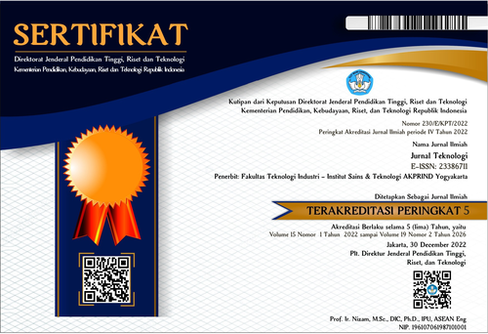Pengukuran Beban Kerja Fisik Menggunakan Cardiovascular Load dan Evaluasi Postur Kerja untuk Mengurangi Keluhan Muskuloskeletal
DOI:
https://doi.org/10.34151/jurtek.v16i2.4051Keywords:
CVL, NBM, OWAS, physical workload, work postureAbstract
CV Dwi Jasa Logam is a company engaged in metal casting. This company places employees in jobs that are heavy on physical exertion in the production process, causing employees to get a high workload. In addition, many employees are elderly, causing them to feel tired more quickly. Employees who are placed on the job, need a longer rest time. When working, employees do not pay attention to work posture while working, so that poor work posture can cause musculoskeletal disorders. The purpose of this study was to analyze the physical workload of employees, analyze musculoskeletal disorders in employees and evaluate employees' poor work posture. The methods used are Cardiovascular Load (CVL), Nordic Body Map (NBM), Ovako Work Analysis System (OWAS). The CVL method is used to calculate physical workload, the NBM questionnaire is used to measure musculoskeletal disorders and identify musculoskeletal disorders and the OWAS method is a method used to assess body posture when working, which is related to body parts such as the back, arms, legs and heavy loads. Based on the results of data processing using the CVL method, there are 20 employees who have a moderate workload level and 10 employees who have a low workload level. Data processing using the NBM questionnaire shows that 8 employees have the highest score in the high risk category, while 22 employee’s other employees have moderate risk categories and data processing using the OWAS method for 8 employees gets category 2 and 3 results, namely improvements need to be made.
Downloads
References
Andriyanto, & Bariyah, C. (2012). Analisis Beban Kerja Operator Mesin Pemotong Batu Besar (Sirkel 160 Cm) dengan Menggunakan Metode 10 Denyut. Jurnal Ilmiah Teknik Industri, 11(2), 136–143.
Anshari, M. H., & Yuamita, F. (2022). Analisis Pengukuran Postur Kerja Menggunakan Metode Ovako Work Posture Analysis System (OWAS) Pada Workshop Reparasi Dan Perawatan Tabung Gas (Studi Kasus: PT Petrogas Prima Services). Jurnal Teknik Industri, 1(1).
Fahmi, S., & Sari, Y. P. (2016). Analisis Postur Kerja Pekerja Proses Pengelasam Batu Akik dengan Metode REBA. Jurnal Optimalisasi, 1(1), 32–42.
Firdaus, M., Ismiyah, E., & Negoro, Y. P. (2022). Analisis Postur Kerja Karyawan Bengkel Bubut Sinta Jaya Menggunakan Metode Ovako Work Posture Analysis System (OWAS). SITEKIN: Jurnal Sains, Teknologi dan Industri, 20(1)
Hakiim, A., Wahidin, S., & Sari, D. A. (2018). Analisis Beban Kerja Fisik dan Mental Menggunakan CVL dan NASA-TLX Pada Divisi Produksi PT X. Jurnal Unsika, 3(2), 1–5.
Kee, D. (2022). Systematic Comparison of OWAS, RULA, and REBA based on a literature review. International Journal of Environmental Research and Public Health, 19(1),
Mohamad, S., Fais, M. A., & Tjahjani, I. K. (2023). Analysis of Improved Work Posture to Reduce Musculosceletal Disorders using the Rapid Upper Limb Assessment and Ovako Work Posture Analysis System methods (Case Study: Employees in the Warehouse of PT. AFS Maros, South Sulawesi). Tibuana, 6(2),
Simanjuntak, R. A. (2021). Memahami Ergonomi. AKPRIND PRESS.
Suma’mur, P. K. (1989). Ergonomi untuk produktivitas kerja. Jakarta : CV Haji Masagung.
Tarwaka. (2015). Ergonomi Indutri: Dasar-Dasar Ergonomi dan Implementasi di Tempat Kerja. Harapan Press Surakarta.
Wijaya, K. (2019). Identifikasi Risiko Ergonomi dengan Metode Nordic Body Map Terhadap Pekerja Konveksi Sablon Baju. Seminar Dan Konferensi Nasional IDEC 2019.
Downloads
Published
How to Cite
Issue
Section
License
Copyright (c) 2023 Kartinasari Ayuhikmatin Sekarjati

This work is licensed under a Creative Commons Attribution 4.0 International License.
Jurnal Teknologi provides immediate open access to its content in order of making research freely available to the public to support a global exchange of knowledge. All articles published in this journal are free for everyone to read and download, under licence CC BY SA.
Benefits of open access for the author, include:
- Free access for all users worldwide.
- Authors retain copyright to their work.
- Increased visibility and readership.
- No spatial constraints.




















